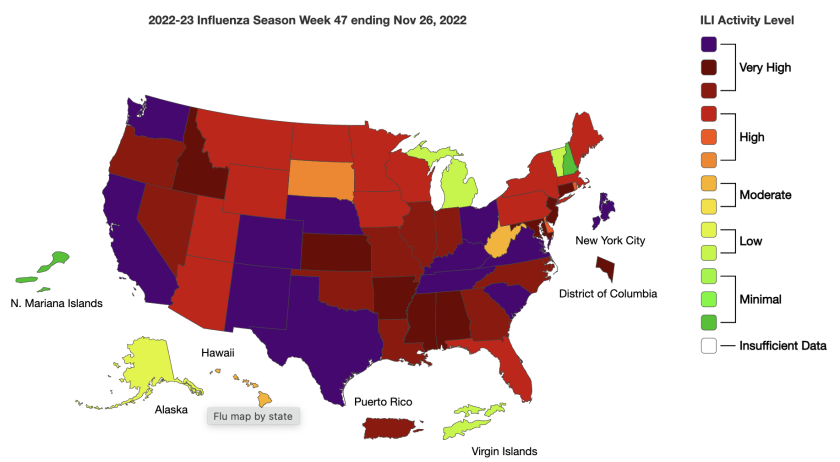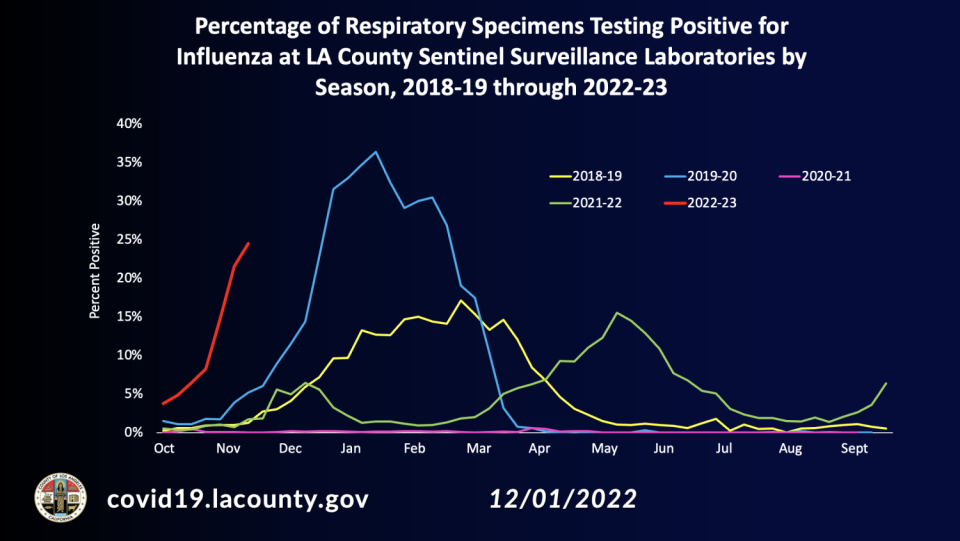'Off the charts': California hit with very high flu activity, among worst in U.S.

California is now reporting very high flu levels, according to the U.S. Centers for Disease Control and Prevention, as the respiratory illness continues to surge nationwide.
The CDC uses five overall levels, from minimal to very high, to measure influenza-like illnesses across the U.S. and its territories. On Friday, the agency's color-coded map showed California and 10 other states, along with New York City, shaded purple, the worst of the three shades in the very high flu level.
Since the start of October, CDC officials estimate, there have been 78,000 flu hospitalizations and 4,500 deaths nationally.
The California Department of Public Health classifies all of Southern California as having high flu levels, while Central and Northern California are rated moderate. Flu is the reason for nearly 4% of hospitalizations each week at Kaiser's Northern California facilities, the highest in any of the prior four flu seasons.
In Los Angeles County, flu and COVID-19 cases are surging, and RSV — or respiratory syncytial virus — also remains at a high level.
"This triple threat … has a lot of potential to cause there to be significant circulating illness and to strain our healthcare system — both in terms of the number of beds that are available and the number of healthcare workers that are impacted by illness, which lowers the hospital's capacity to take care of patients," L.A. County Public Health Director Barbara Ferrer said in a recent briefing.
The flu positivity rate in L.A. County has reached 25%, a level not seen at this time of year in the last four years. "Clearly, we're ... off the charts," Ferrer said.
"We already are seeing many individuals hospitalized for flu-related illness and complications. So please, we urge people to not just think of this as 'just the flu.' It's not too late to get your seasonal flu shot," she added.
California has recorded at least 36 flu-related deaths since the start of October, based on death certificate data. That figure is probably an undercount.

The positivity rate for RSV also remains elevated — around 15%, higher than in any of the four prior cold-and-flu years, which run October through September.
There are some indications that RSV activity may have peaked in L.A. County in early November and is starting to decline. In late October, the positivity rate exceeded 20%, according to county data. But it's possible the 15% rate is simply a result of more people being tested for the virus, Ferrer said.
"The current percent positivity, even while it's dropped, still surpasses the highest percent positivity values seen for our last five seasons," Ferrer said. "So, still an alarming number of people who are testing positive for RSV."

At Children's Hospital Los Angeles, the RSV positivity rate is 23%. That's dropped considerably from Nov. 1, when the rate was 38%. But the latest figure is still quite high and is about the same as during the peak for all of last winter, which was 24%. The emergency room at CHLA is so busy that it cannot always accommodate patient transfers from other hospitals.
The positivity rate for flu at CHLA is 19%; before Thanksgiving, it was 12%.
Orange County's RSV situation remains the same as it was the prior week, according to its Health Care Agency, where officials declared a public health emergency over RSV and other viral illnesses stressing children's hospitals.
Increasing coronavirus-positive hospitalizations are exacerbating the RSV situation, as a rise in COVID-19 hospital patients means there's fewer hospital beds available, the agency said.
At Kaiser's Northern California hospitals, about 2.2% of hospital admissions are related to RSV, down from 2.3% last week, according to the most recent available data. Those rates are higher than in the five preceding cold-and-flu seasons.
There have been at least 14 RSV-related deaths, according to California death certificate data, since the start of October. The figure is probably an undercount.
"Given the high levels of RSV activity, caution is warranted," Ferrer said. "RSV often impacts young children most severely and causes bronchiolitis [inflammation of the airways] and pneumonia. It's important to take precautions to prevent respiratory illnesses. This includes washing your hands often, and for RSV in particular, wiping down frequently touched surfaces."
In addition to wearing a mask, health experts say one of the easiest ways to reduce your risk of catching the flu or other viral illnesses is to avoid touching your face.
The CDC notes that people can be infected with flu and RSV by touching contaminated surfaces, where some viruses can survive for days, and then their face.
“The one point I want to reemphasize is … avoiding touching your eyes, nose and mouth,” Dr. Ralph Gonzales, a UC San Francisco associate dean, said at a recent campus town hall. “Very good studies have shown that if we can double down our efforts to be vigilant about this, that will increase our chances of staying flu-free.”
Still, this simple-sounding advice may be easier said than done. Touching your face can be a spontaneous or even subconscious act that some research indicates can help us deal with anxiety and discomfort, or be related to negative or dissatisfactory feelings.
And it’s something that happens a lot. A study from 2015 caught medical students in class touching their faces 23 times per hour on average.
Here are some tips on how to train yourself to avoid touching your face.
Be mindful when you do touch your face, and catch yourself when — and, preferably, before — you do it.
If you catch yourself before touching your face, consider folding your hands or doing something else with them.
Got an itch? Try to ignore it. If that’s bothersome, wash your hands, then scratch it, then wash your hands again. Or buy sterile wooden tongue depressors to use as a tool to scratch itches.
Regular hand-washing is also an important step to help thwart viral spread, officials say. When soap and water aren’t available, hand sanitizer can be used as a substitute.
This story originally appeared in Los Angeles Times.

